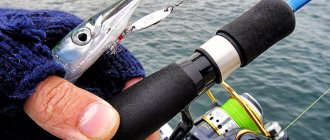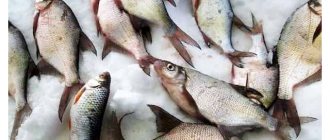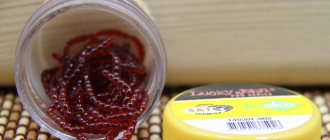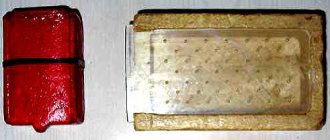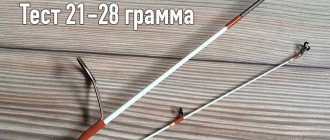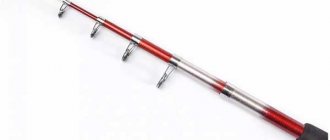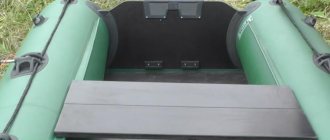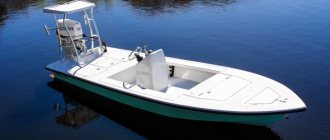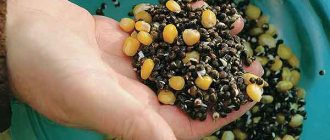Preparing bloodworms for the winter is a labor-intensive task and in most cases this is done by the people who sell them. To store bloodworms in winter, they use cellars and basements where they keep bloodworms in special containers in silt. Bloodworm traders can also obtain bloodworms in winter by drilling a hole in a reservoir and scooping up silt from the bottom.
A bloodworm is the larva of the bell-bellied mosquito. Aquarists use bloodworms to feed aquarium fish. Bloodworms are considered valuable live food, and if you have the opportunity to feed your fish bloodworms, never miss this opportunity.
Bloodworms are sold at the poultry market not only in summer, but also in winter, although in winter the price of bloodworms increases significantly, but if you want to save your money on bloodworms, then you will have to wash the bloodworms yourself, which in my opinion is not at all difficult to do.
The exact location of the bloodworm in the area is lowlands overgrown with nettles with flowing small and calm silted streams, as well as small silted reservoirs in which, as a rule, there is no fish. There are several ways to catch bloodworms, but I want to describe the method that I use myself.
To wash bloodworms, I use a tray made of fine-mesh metal mesh, the approximate size of the cells being equal to the thickness of a match. It’s easy to make a tray yourself; you just need to carefully bend the edges of the mesh; the size of the tray itself can be arbitrary.
For 4-5 days, bloodworms can be kept in large tubers, fruits, for example, potatoes, cucumbers, zucchini, etc. Having cut off the top of them, select the middle, put the larvae into the resulting cavity, add some drunk tea, close it like a lid cut off earlier piece and fasten both parts with pins, wire matches. Let us specifically note that live bloodworms taken for fishing are sprinkled with starch so that they do not stick together.
Getting bloodworms - Option No. 2 from A. Gritsenko
But there is, in my opinion, a simple, easy and original way. You need to take a bag made of coarse fabric or a mesh (anti-mosquito) with a mesh size of 2-3 mm, put pieces of chopped fish or meat and a weight inside. Tie a cord and use it to lower the bag onto the muddy bottom from the bridge, from the boat and into the ice hole. After 2-3 days, clean bloodworms will collect in it. This method is good because it is applicable both in summer and winter. There is no need to go to the market or dig through dirty mud.
Author: Anatoly Gritsenko
Bloodworm is the most common bait among fishermen not only in winter, but also in summer. For bloodworm fishing to be successful, every angler must know how to wash, store and properly attach bloodworms.
Review of ready-made baits for winter
To all baits, no matter ready-made or homemade, you should always add a nozzle and bait with which you are currently catching, for example, a handful of bloodworms.
Usually four types of branded Dunaev winter mixtures DUNAEV-READY are used. Here you can immediately mention “ Universal ”. It is usually used on all types of winter fish. The bait is dark brown in color. This mixture resists frost well, that is, it does not freeze as quickly as other mixtures. It also does not spoil for a long time. And this is what is called “rancid” bait, which will not attract fish, but will rather scare them away.
Tips for fisherman: Which winter fishing rod is best for trolling - Choosing the best
The “Motylnaya” bait attracts winter fish very well, but it should be taken into account that along with peaceful fish, predators can also approach the hole. This bright red bait contains about 10% natural bloodworms.
The bait mixture "Bream" has an excellent ability to lure bream to the hole, but there is one unpleasant moment. This ability of this bait may not manifest itself in all reservoirs. This must be verified experimentally.
The bait "Roach" is also universal. It attracts almost all fish, but it contains components with a dusting effect. Therefore, small things can also fit into the hole.
Fishermen are often concerned about how to properly store bloodworms so that the fish will enjoy them for as long as possible. Storing bloodworms at home is quite difficult. It crushes easily, but there are several ways to keep the bloodworm alive. These methods are somewhat similar.
Photo 1. Extraction of bloodworms.
This method is not the only one. Catching bloodworms can be done in a gauze cloth with large holes or in a thin-woven bag. The trick is that you need to put a piece of fish, meat and a weight in the bag that allows you to lower it to the very bottom. After several hours, the bag is removed from the water, and the accumulated larvae are collected by hand.
Experienced fishermen advise how to catch bloodworms on a device such as a string. A fishing line or wire is pulled tightly onto the frame and used to comb the bottom of the reservoir. The strings touch the larvae, and they wrap themselves in rings around them. Then the rings are washed off into a tank or bucket of water. Unfortunately, this method damages many larvae.
When sorting, the bait should be placed in a fine-mesh sieve. Then the sieve should be immersed in a container that is first filled with water. After a short period of time, small larvae will crawl through the cells into the container, but large ones will remain.
At the selected location, a hole is cut approximately 1.00 - 1.50 x 1.00 - 1.50 meters. The hole can be cut with a sharp hatchet. During the cutting process, the resulting crumbs are immediately removed from the future ice hole. Until the edges are cleaned, water should not be allowed to enter the hole. If the water rises, further cleaning of the ice hole becomes an unpleasant task. For such circumstances, it is necessary to provide a tool like an ice pick.
How to store bloodworms.
Storing bloodworms at home is not quite a troublesome task, but the operations below must be carried out regularly . Bloodworms are usually stored in the refrigerator in a glass jar. At the bottom of which the larvae are laid out in a layer of no more than one centimeter and filled with cold water. The water needs to be changed every two days. During washing, dead larvae simply need to be selected using tweezers.
To preserve bloodworms while fishing , especially in winter frosts, you need to prepare in advance. To do this, before fishing, dry the bloodworms on newspaper and sprinkle them with starch, and then place them in an insulated (foam plastic, fur) bloodworm container, which is placed in a jacket pocket closer to the body. There is also no need to heat the larvae too much, the main thing is that they do not freeze. Modern winter fishing suits have a special insulated pocket for storing bait and protecting it from freezing.
Experienced feeders have been convinced more than once that the hottest months are the period for universal baits, such as mosquito larvae. Both peaceful and predatory fish bite well on them; they are noticeable and attractive both in still water and in the current. Therefore, you just need to know how to get bloodworms in the summer in order to hunt for trophies and return home with a good catch. We will be happy to tell you about this.
How to prepare bloodworms
In winter, the use of high-tech modern gear is very difficult, and that is why fishermen prefer to use bait in the form of various live baits. These are, as a rule, mosquito larvae and other small things that can attract the attention of redfin fish with a rather moderate appetite at this time of year due to the lack of desire to leave the relatively warm regions of reservoirs near the bottom.
Beginning ice fishing enthusiasts have questions about how to prepare bloodworms in the evening. The answer to this is simple: first of all, you will need a container made of foam material for storing various types of materials, visually reminiscent of foam plastic.
This container needs to be treated with iodine. You can take a simple iodized pencil, which costs mere pennies in almost any pharmacy, and draw a grid on the inside surface of the box. Next, lay out the larvae exactly in the quantity that you will need the next day.
The point is that the jig will already be attractive to the eyes of the river striped robber, but overnight it will infuse and become saturated with iodized smell, which will make its “popularity” among the perch increase several times!
Before baiting the hook, we take the bait out of the cocoon. Externally, the caddisfly is similar to a large maggot, but a little larger and with a more pronounced head. You can bait the larva near the head, but, in my opinion, it is better in the middle of the body.
In the vast majority of winter, anglers fish with jigs and know that the catch is influenced not only by the technique of the game, the selection of bait, but also by the choice of the right bait.
In addition, bait can only successfully catch one specific fish. Let's say, sometimes there are days when the chebak or dace do not favor bloodworms, so give them maggots. But perch and ruffe are practically not taken on plant baits, and thus they can be quite easily weeded out when catching other fish.
Even from these most obvious facts we can conclude that a competent choice of bait largely determines the success of fishing.
Bloodworm
Before you lower the bait bloodworm into the hole, you need to cool it a little so that it is not too mobile, then it will not burrow into the bottom soil so quickly. Some people suppress it in their palms, but I seriously doubt that this is a more effective method than cold.
The bloodworm must be hooked by inserting the sting of the hook into the body of the larva towards the darker head than the tail, or, if the bite is very weak, in a ring, piercing both the head and the tail. It is important not to crush, but to pierce through so that the body remains intact. You can put two or three bloodworms on the hook at once. For bream, you can make a larger bunch: 3-5 bloodworms.
Maggot
The name of this larva comes from the word “dough” - this is a dough that, after standing in a warm place, increases in volume. So the larva increases in weight by more than two hundred times in a week.
Maggot is a good and strong bait. If you can catch the same with bloodworms and maggots, then it is more practical to fish with the latter - you need to change the bait 2-3 times less often, and sometimes the fishing speed is a decisive factor.
After bloodworms, I consider maggots to be the second most important bait for jig fishing. A universal bait for catching any fish. In recent years, maggots have appeared in a variety of colors and smells. It’s a matter of each fisherman’s taste as to which maggot to choose for fishing, but it’s better to take several colors at once, in case the fish likes one more.
In Europe, maggot is the most common bait for catching almost all types of fish. All maggots offered for sale in Europe are grown from fly larvae imported from Kenya. Food coloring of red, green, yellow or brown is added to feed consisting of chicken broiler processing waste to obtain marketable larvae of the appropriate color.
It is better to store maggots in a box somewhere in the inner pocket of your jacket. But this does not mean that the bait is afraid of the cold; it all depends on what kind of maggot you have. If this is a special technologically diluted maggot, then it will come to life both overheated and supercooled, while an ordinary one can withstand freezing only once, the first and the last.
Tips for fisherman: What to use to catch grayling under ice in winter - Answers for beginners
An ordinary maggot in a warm place will soon pupate, but a frozen one will, of course, defrost, but it will also die very quickly after that, and you won’t be able to use it a second time. Maggots that have turned into brown barrel pupae are called casters. The fish bite on them worse, but they can be added to a “sandwich” (white maggot and red-brown caster) or used for bait.
The maggot is baited by the head so that its tail moves actively. You can put 2-3 maggots on the hook at once. It is good in a “sandwich” of maggots. There is also a nuance that is worth paying attention to: often the fish begins to perceive the bait for size, and then you need to look for the smallest and fastest maggots and put them on the hook one at a time. It would seem like a trifle, but more than once it was a decisive factor.
Worm
I have noticed that our Siberian chebak often bites on a worm with greater pleasure in the middle of winter than on bloodworms or maggots. Knowing this fact often comes in handy when you need to catch live bait and, of course, chebak.
What's bad about a worm for winter is that it doesn't like the cold. Therefore, it must always be kept warm. In addition, if you have a home-grown worm, before fishing you still need to prepare it, that is, get rid of the smell of rot and earth. The easiest way is to leave the worms overnight in a container with dried tea (tea leaves). If you stock up on sand in the summer, you can clean the worms by keeping them there.
We usually put a piece of worm (tail or head) on a standard jig. It may not look any more appetizing than a bloodworm, but the worm bleeds more and emits stronger odors that attract fish. It’s impossible to list all the nuances, and you get many answers to questions directly while fishing.
Chernobyl and burdock
These larvae live in the stems and fruits of plants, and this is not only burdock and Chernobyl, but also burdock and other large plants. The larvae live inside these plants all winter, and they can be collected immediately before fishing. Some fishermen prepare stems with larvae in the fall and store this bait in their closet.
When fishing, you need to store the larvae especially carefully so that the leftovers will be useful on your next fishing trip. And if you do happen to freeze the larvae, then you still need to put the box in which you stored them while fishing in a cool place—they will withstand one more defrosting.
In appearance, the burdock is not so different from the maggot, but who, the fish, knows why it often makes a choice between two seemingly identical larvae in favor of one. There are many examples of this - again, let’s remember how often when fishing a fish takes a dung worm, but ignores an earthworm.
As is the case with all larvae, when baiting a burdock moth on a hook, it is better to catch it on the skin near the black dot on the head.
Caddisfly
Both in winter and summer you can find this bait on the shelves of our Siberian fishing stores. Caddis flies are the larvae of various butterflies. But we call them all caddisfly, since their general structure is the same - it is a larva living in water inside a cocoon. It can be made from a variety of natural materials: sand, plants, twigs and foliage. And the colors of a caddisfly cocoon can be completely different.
The caddisfly is an attachment that does not always produce results everywhere. You just need to have it with you so that sometimes it works one hundred percent. It happened more than once that when fishing with caddis flies, much larger perches were caught than were previously caught with bloodworms or jigs.
Before baiting the hook, we take the bait out of the cocoon. Externally, the caddisfly is similar to a large maggot, but a little larger and with a more pronounced head. You can bait the larva near the head, but, in my opinion, it is better in the middle of the body.
Mormysh
Mormysh and jig are twin brothers, at least outwardly. But, for the most part, we use jigs only for feeding fish. Attempts to catch only with jigs brought results, but significantly worse than with bloodworms and other baits. I think that a lot depends on the region and even a certain body of water in Siberia, because this aquatic amphipod does not live everywhere and not in the same quantities.
Having poured a bunch of jig onto the bottom of the reservoir, under the hole you can watch how it begins to swarm and crawl to the sides, which attracts fish to your fishing spot. Even if the fish does not want to bite off the jig, it will still hang around in this place and sooner or later it will grab one of the offered baits. But as a bait, mormysh has no competition and in combination with other baits gives good results.
Victor Kovantsev, Tomsk.
Did you like the article? Subscribe to the channel to stay up to date with the most interesting materials
When was the last time you caught dozens of HUGE pike/carp/bream?
How to get bloodworms in the summer using a bag
A very interesting method, although it takes time to implement.
Take a rag bag and fill it with foam rubber, rags, old washcloths, add chopped offal and fish, as well as a stone or brick as a load.
Tips for fisherman: Fishing for grayling in small rivers in summer - Detailed review
Throw the made “trap” into a pond with a muddy bottom and wait 1-3 days.
You take out the bag, pull out its contents and select bloodworms from rags, foam rubber, and old washcloths.
Of course, this method is for those who have time and who do not disdain fiddling with fish, meat, and mosquito larvae. But even preparing porridge from peas and millet requires effort, and when fishing there is no place for excessive suspiciousness and scrupulousness, and the bait, if used correctly, promises to be very catchy. So don’t wait, get bloodworms in the summer and fish out trophies on them.
Since it is not difficult to get bloodworms in the summer, it can be used for fishing at any time of the year. But to prevent the bait from dying, it should be stored properly. It all depends on the season and the needs of the fisherman.
How to wash bloodworms
Bloodworm (raspberry) is the most popular bait among anglers. It’s hard to imagine a fisherman with a fishing rod in winter without these red worms. In the fishing community, this bait is loved for its versatility and accessibility. If you wish, you can wash the bloodworms in the nearest body of water. If you really don’t want to bother, then just buy it in the store.
What is a bloodworm?
Many fishermen and nature lovers know that bloodworms are mosquito larvae. Just not that biting insect that spoils a person’s outdoor recreation in the summer, but the harmless jerk mosquito of the chironomidae family. These mosquitoes always live close to water, where they lay eggs, from which one day red larvae look like small worms.
Variety of larvae
In general, there are more than five hundred species of mosquito larvae in nature. Mainly three types are used as bait and groundbait: small bloodworms, large ones and estuary ones.
Small and large bloodworms live everywhere in freshwater bodies. Large larvae can be somewhat more difficult to obtain; they live in heavily swampy rivers and lakes.
Limannik does not have a fixed size; there are both small individuals with a size of 2-3 mm, and quite large ones. It differs from other species in its saltiness, as it lives in the estuaries of the seas. The larvae got their name from their place of residence.
Bloodworms feed on small organic matter. Eats food of plant and animal origin, willingly gathers for carrion.
Fishing use
You can catch almost any freshwater fish with bloodworms that is at least somehow interested in animal food.
The best time to fish for bloodworms is autumn, winter and spring. Even in summer, especially on cool days, roach, small bream, crucian carp and many other fish bite well on such a bait. Bloodworms are often used in fishing methods such as feeder fishing, summer and winter fishing rods.
Methods of extracting bloodworms
The larva is found in water, or rather, in a soft muddy bottom, in relatively shallow water. The thickness of the bottom silt remains cool even in the summer heat, which must be taken into account when storing larvae. Most often they are found in swamps and grassy coastal areas of water bodies. People learned to wash raspberries a long time ago. Here are some proven effective methods.
Extracting bloodworms using a pump
In industrial quantities, larvae are obtained using a special pump, the operating principle of which is as follows:
- The water pump (pump) is placed on the shore, and the hose is directed directly into the mud. When the pump is turned on, the grounds are sucked in and moved through a hose into a device that resembles a large colander.
- Colanders can be placed in several rows as the diameter of the holes decreases. The larvae are usually retained on the lower sieve or even on the mesh.
- By processing a large area, you can get quite a lot of bloodworms and relatively quickly. There are also disadvantages to such mining. Many larvae are injured and die, which requires mandatory bloodworm sorting. The shelf life is reduced.
Mining by bucket
Extraction of bloodworms using a bucket with a fine-mesh metal mesh. A rope is tied to the handle of such a bucket, and a simple tackle is thrown into the water.
After this, they begin to slowly pull the bucket onto the shore by the rope.
The soft, superficial layer of sludge is filled into a bucket. All that remains is to wash all the silt out of the bucket.
To do this, they go into the water about knee-deep and begin to rinse the container with the contents under water.
Black dirt will come out, moving bloodworms and a few other small living creatures will remain at the bottom of the bucket. You just need to sort the larvae from the few small debris and bugs.
Extraction by dredging
The method is suitable for the cold season. It allows you to quickly wash a large number of larvae.
A square hole is cut in the ice, into which a device resembling a stretcher is installed. Its bottom is made of fine mesh, the same as on the bucket from the previous method.
Next, a sufficient amount of silt is caught with a scoop and placed in a “drag” installed in the ice hole. By washing the contents from the “stretcher” in water, the turbidity goes under the water, and the larvae remain on the sieve.
Guitar for washing bloodworms
A method that does not have a sieve and does not require long washing. You can use ordinary pitchforks, the horns of which need to be tied with thin wire, like strings.
This device is used to plow through the silt and some larvae will get caught. All that remains is to carefully shake off the larvae and collect them.
This method is less dirty, but not as productive as those that involve washing.
Gauze trap
A bag is embroidered from gauze or similar fine mesh, and a rope is tied to the neck. To make throwing easier, the bag is slightly heavier. It is enough to put an ordinary stone and bait inside. Bloodworms feed mainly on dead organic matter, so you can use a piece of meat or fish.
The prepared bag is thrown into the water, onto a wetland with a muddy bottom. In such places you can find bloodworms of almost all sizes. Usually these are windows among vegetation with a depth of no more than a meter. The trap is left for about a day. All that remains is to carefully take it out and collect the crawling bloodworm.
A simple jar trap
Some fishermen catch larvae using simple traps, which are still found in villages.
The trap can be made from a large tin can, without a lid.
The bottom of the jar is perforated with small nails until it looks like a sieve. A special bracket made of thick metal wire is attached to the top side.
The bracket is connected to a wooden or telescopic pole made of any convenient, preferably light, material.
In general, the trap is a movable scoop with a sieve bottom. With such tackle, the dirt is raked through a regular hole, and washed in it, raising it to the surface.
Mining with an ice drill
This simple method is used in winter; it is suitable for quickly collecting small quantities of larvae. With an ice drill, bloodworms are caught in shallow muddy areas of rivers, lakes or ponds. Extraction occurs as follows:
- In an area with a depth of no more than half a meter, a hole is drilled in the ice.
- The ice auger must be partially screwed into the mud, and then the stuck dirt must be sharply pulled out.
- Shake it several times and scoop the dirty water onto the ice and collect any larvae that come across.
On a note! The advantages include the speed and simplicity of the method. Having quickly checked the crop from one hole, you can drill the next one. But there are also disadvantages. Finding ruby worms in pieces of sludge is much more difficult than after washing with a sieve. In addition, ice drill knives quickly become dull from frequent contact with dirt.
Conclusion
Bloodworms are sold in almost every locality for little money. There is no need to waste time and energy. However, in some cases it still makes sense to extract it yourself.
As a rule, bloodworms obtained immediately before fishing are much fresher and more mobile than purchased ones.
During periods of poor bite, it can be useful to use semi-washed sludge with very mobile larvae as bait or as an additive to the main feed, which will additionally attract fish by swarming in the ground.
Source: https://ribolovrus.ru/prikormki-i-primanki/kak-namyt-motylya
Extraction methods
This bait can be purchased ready-made in a specialized store. However, you can get it for free. But you will have to try hard for this.
Bloodworms love silt, but are afraid when it heats up and disintegrates, as the amount of oxygen suitable for life decreases. Therefore, you can bring a bucket of sludge home and put it on the stove to heat it. Subsequently, the bloodworm itself will swim to the net.
There are more than 600 species of mosquito larvae in nature. Only 3 species are used in fishing: Small bloodworm , also called river bloodworm. This species can be found in shallow freshwater bodies.
Industrial extraction of bloodworms video
In winter, fishing with artificial bait can be very effective. This is explained, first of all, by the fact that at this time of year the fish are not so picky, especially during the period of first ice and last ice. Then the easiest way to outwit it is with artificial bait, pretending to be a live bloodworm.
By playing with a jig, the fisherman gives a signal to the fish that the bait is edible. This is why fishing with baitless jigs and jigs with artificial baits is successful. The most common of them is bloodworms, since they are the favorite food of most species of fish, both peaceful and predatory.
Readers probably immediately have a question: what is the point of catching an artificial bloodworm if there is a real one and the whole difficulty lies only in its correct attachment to the hook? The thing is that real bloodworms do not appear on sale immediately, but only some time after the ice has hardened on the reservoirs and its mass production begins.
You can get bloodworms yourself, but this is a very difficult matter. In the summer, natural bloodworms are extremely rarely on sale, but artificial ones are available in every store.
In addition, bloodworms are difficult to store - they quickly deteriorate in warm conditions and freeze in the cold.
It is also worth noting the fact that the bloodworm does not hold well on the hook if it is not attached correctly, but in the cold not every angler will want to do this.
You need to attach an artificial bloodworm to a hook, in principle, in the same way as a natural one - you can use a brush or a bunch, or you can use a ring. To do this, a silicone worm is pierced through below the head and the hook sting is covered with the tail of the bait.
Or you can stretch the tail a little so that it bends as you move the jig, imitating a living larva.
The “sporting” method is also suitable - for this, the imitation is pierced, but the sting is not brought out, but is hidden either at the head or at the tail end.
It should be remembered that silicone products from unknown manufacturers often stay on the hook no better than natural bloodworms.
So you shouldn’t save, but it’s better to immediately buy quality products from well-known companies (Berkley, Lucky John, etc.).
Unlike silicone bloodworms, rubber ones are much stronger and hold better on the hook, but almost no one releases them. True, you can cut it out of an inflatable ball yourself, as they did before.
It is best to fish with artificial bloodworms, constantly playing with the tackle, but in some cases the fish grabs the bait hanging motionlessly - it looks so realistic.
The bait can be placed several times on the hook, alternating it with real bloodworms, thus saving time after each bite. You can also attach an artificial one to an additional hook, which is tied to the fishing line.
During the game, the bloodworm on the hook will move, thereby attracting fish.
Source: fish.rybalkanasha.ru
Bloodworm extraction method No. 1
Sludge with bloodworms We go to the pond where we will get bloodworms with a bucket and a shovel. We extract silt and fill a bucket with it, and return home with a full bucket.
Having brought a bucket of sludge home, we put it on the stove or something else warm. When the sludge begins to warm up, it will decompose and absorb oxygen, this will force the suffocating bloodworm to come to the surface.
All that remains is to collect the crawling bloodworms.
Bloodworm extraction method No. 2
ladle for washing bloodworms You can catch bloodworms with a small landing net, something like a ladle with a fine mesh instead of the side walls and bottom. In this case, the neck should be very rigid. You need to lower the bucket into the hole and collect silt or sand.
Raising the contents to the surface, rinse the sludge in water; the neck should be above the water level. After rinsing the sludge a lot, stop - the bloodworms will float to the surface. It can be collected with a fine strainer.
With this method of catching bloodworms, you will come across larvae of different sizes; they can be sorted. Pour the collected bloodworms into the water and first take a strainer with a larger mesh.
Small bloodworms will pass through it; they can be collected with a fine-mesh strainer, which was originally used for fishing. Small bloodworms are often used as bait or groundbait.
Bloodworm extraction method No. 3
Bloodworms can be caught at night using light. To do this, you need to shine a powerful flashlight into the water for quite a long time. After some time, bloodworms begin to collect on the surface of the bottom, which are easy to collect with a net.
Bloodworm extraction method No. 4
Catching bloodworms with a pitchfork The fourth method of catching bloodworms is faster, but has its drawbacks. We take an ordinary pitchfork and wind 2-3 millimeters of wire across the rods. Maintain a distance of 3-4 centimeters between the wires.
Having securely secured the wire, we lower the forks into the hole, not at a right angle. By resting the handle on the edge of the hole, you will have leverage that will ease your efforts and increase your range of action. Having reached the bottom, we deepen the forks into the silt and push them through the silt.
Taking out the pitchfork, you will see bloodworms collected with wire. Just put the forks in a bucket of water and rinse a little. The advantage is that there will be no small bloodworms, and the time spent catching them is significantly reduced.
The disadvantage is that bloodworms caught in this way are not stored for a long time, as they are slightly damaged.
Bloodworm extraction method No. 5
I like this method more than others. Since you can get bloodworms without particularly straining, and throughout the winter.
You need to make a bag from thin gauze or other cellular material (so that bloodworms can crawl through), throw a weight and a piece of meat or fish into the bag and throw it to the bottom. The next day we take out the bags, remove the bloodworms and lower them back to the bottom.
For convenience, I tie a rope to a stick that freezes into the hole. And to get it out, I drill a hole nearby and use a wire with a hook at the end to hook the rope and pull out the bag.
Bloodworm extraction method No. 6
bucket for washing bloodworms This method of washing bloodworms is also not bad if it’s warm outside and you’re going fishing tomorrow, the day after tomorrow... They cut a hole in the ice so that the bucket can fit freely. Using a shovel, we put the sludge into a special bucket for washing (shown in the picture).
We wash the sludge in the hole with sharp movements from side to side (up, down). When the silt is washed, raise the bucket to the surface for 5-10 seconds and gently lower it into the water. The dried bloodworm will float up, we collect it with a net.
If it’s cold outside, or you want to be warm, you can dump the washed sludge from the bucket into a regular empty bucket and bring it home. At home, while sorting out the garbage, select bloodworms for the upcoming fishing trip.
PS
Based on these methods of extracting bloodworms , a simple conclusion can be drawn. Washing bloodworms yourself is not so difficult, and you will save a lot of money, especially if you plan to use it as bait. Of course, if you don’t have time, you can buy bloodworms in the store, but often the quality of the bloodworms in the store is not comparable to the bloodworms you get yourself.
Source: ribalka-rf.ru
Industrial extraction of bloodworms video
Source: https://shelbymiguel.com/other/dobycha-motylya-promyshlennym-sposobom-video.html
Bloodworm extraction.
There are more than 600 species of mosquito larvae in nature. Only 3 species are used in fishing: Small bloodworm , also called river bloodworm. This species can be found in shallow freshwater bodies.
Limannik, this species does not have a constant size; there are both small individuals with a size of 2-3 mm, and quite large ones. It differs from other species in its salty taste and is located in the estuaries of the seas, which is where the name comes from.
Large bloodworms live in freshwater bodies of water. It is more difficult to find in rivers; most often it is found in swamps and lakes with a rich muddy bottom. It is quite large in size, which makes it easy to attach to the hook. When immersed in water, it sinks faster due to its weight, and is most attractive to fish.
Extraction methods.
- The easiest way to get bloodworms is to simply scoop up sludge from the bottom of a reservoir with a ladle, bucket or sack, then put it in a sieve and rinse with water, sand and other particles with debris will go away, but the larvae will remain. This method is simple to perform, but is not suitable for the winter season.
- The extraction of bloodworms can be carried out in other ways; they take more time, but cause the least harm to health. It is necessary to take a fairly powerful flashlight with a bright beam and illuminate the water with it, but only in the same place, the mosquito larvae will be collected in the light, all that remains is to collect them with a net.
- For the next method, you can take a bucket and scoop up sludge from the bottom of the reservoir, bring it home and put it on the stove; at high temperatures, there is less oxygen, the sludge begins to disintegrate and the bloodworms float to the surface.
- You can sew a gauze bag into which bloodworms can easily penetrate. It is necessary that the bag has a long rope, which is required to lift it from the bottom of the reservoir. Inside the bag there is a fairly heavy stone and bait (small pieces of meat, fish). The next day, you need to lift the bag containing the larvae.
Bloodworm extraction for sale.
The above methods allow you to collect larvae for household use. But bloodworm extraction is also the main source of income for many people. The bloodworm trade already requires special devices in order to lift the maximum number of larvae from the bottom.
A bloodworm is a long-legged mosquito larva that lives in the mud at the bottom of most bodies of standing water. Nigel Bull says the hardest part is finding a suitable pond - once you've done that, the job is 99% done.
The bloodworm is visually similar to a red worm 10-15 millimeters long. Bloodworm is one of the best and most common baits for fishing. More often bloodworms are used for winter fishing, less often for summer fishing. In winter, bloodworms are sold in almost all fishing stores, but if you decide to save money or do not have the opportunity to buy bloodworms, then there are several simple ways to get them.
Tips for fisherman: Spinning bait for asp in summer - Features of choice
To extract bloodworms from the ice, you need to cut a hole 1 square meter in size. Using a stick with a scoop attached to the end, you need to remove the sludge from the bottom of the reservoir and wash it through the mesh on site. The size of the mesh cell will directly determine the size of the bloodworm. To ensure safety, a warning sign must be placed after using the hole. In the summer, bloodworms are usually caught either from the shore or from a boat with an iron bucket tied to a rope. Use a bucket to scoop up the silt and bring it to the surface.
Afterwards the sludge is washed and the remaining bloodworms are collected. The next method of obtaining bloodworms is even simpler: Take a fairly large bag of coarse gauze, into which you place a stone and pieces of fish or meat. The bag with all the contained parts sinks to the bottom and is pulled out after a day. The accumulated bloodworms in the bag do not have time to leave it and, safely for the fisherman, are removed to the surface.
If there are rather shallow places in the reservoir, then use a bucket to scoop up the sludge from the bottom and place it near the fire. The bloodworms will begin to float up when they sense the warmth, and should be collected from the surface with a net. Large larvae are used as bait, but small ones are used as complementary food .
How to find a body of water
A bloodworm is a long-legged mosquito larva that lives in the mud at the bottom of most bodies of standing water. Nigel Bull says the hardest part is finding a suitable pond - once you've done that, the job is 99% done.
Although most bodies of water have bloodworms, not all of them have enough of them to make it worth trying to wash them up. Some ponds are not suitable because they are too deep or the mud is too soft so you won't be able to get the larvae out of the water without damaging them. It is not surprising that when a fisherman finds a suitable body of water, he does not tell anyone where it is.
Where there is manure...
Find a small pond in your pasture. When manure gets into the water it attracts. To live, the bloodworm needs a layer of silt of about 35–40 cm, but remember that in order to wash the bloodworm, you will have to get into the water. Obviously, it is dangerous to wander on the soft bottom even in small bodies of water.
Make sure that the depth, given the thickness of the silt layer, is not too deep. Even in a pond 45 cm deep, the layer of silt can be up to 1 m thick or more. Beware of depressions where the layer of silt may be even thicker. Ideally, the layer of silt should be on top of the pebbles or clay, otherwise you may go too deep.
A layer of leaves or algae usually gets in the way, so avoid ponds surrounded by trees.
Always ask the property owner's permission before entering a pond. If there are no more than two or three people washing bloodworms in the pond, then most likely the owners will not object - in fact, they may even be happy that you will reduce the bloodworm population in their pond - but take enough so that there are some left in the pond enough bloodworms for further reproduction.
How to find bloodworms
There is only one way to find out whether a pond is suitable or not - to try to wash bloodworms.
Check the recesses. The bloodworms are not scattered in an even layer over the entire bottom - they usually collect in the depressions. Sometimes this is only 1–2 m2 in area. There are few bloodworms in the areas of the bottom between the depressions. You might think that there is just as little of it in other places. But check the recesses and you'll find what you need. First try to wash the bloodworms in several places, and then decide whether the pond is suitable or not. Look for areas where the mud is soft and clean and free of algae, leaves, twigs and rocks.
A swarm of mosquitoes above the surface of the water should lead you to believe that there are bloodworms here. But this does not mean that if there are no mosquitoes, then there are no bloodworms either.
Direction of the wind. Often on ponds the wind blows in the same direction and knocks insects to one of the banks. Check these areas first.
Temperature change. In summer - when the water and silt are warm enough - the bloodworm lives at a depth of several centimeters from the bottom surface. When the temperature drops, it goes deeper. In winter, you need to look for it at a depth of 30 cm, or even more.
Bloodworm is one of the most common baits for fishing. It is used not only in winter, but also in summer, spring and autumn. This small red worm gained popularity due to its attractiveness. The fish responds well to both its color, smell, and the activity of the larvae. Bloodworms are mosquito larvae and live in the mud at the bottom of water bodies. Many different fish bite on it, including bream, crucian carp, perch, and roach.
Bloodworm is one of the most common baits for fishing. It is used not only in winter, but also in summer, spring and autumn. This small red worm gained popularity due to its attractiveness. The fish responds well to both its color, smell, and the activity of the larvae. Bloodworms are mosquito larvae and live in the mud at the bottom of water bodies. Many different fish bite on it, including bream, crucian carp, perch, and roach.
Tips for fisherman: How to catch bream on a fishing rod in summer - Features of choice
You can get bloodworms in another way. But this method takes longer. To do this, wrap a stone, a piece of fish or meat in a small piece of gauze and lower it into the muddy bottom. After a day, the homemade trap rises to the surface and the accumulated bloodworms are removed from it.
Another option for obtaining larvae may be a simple method. In shallow water, silt is scooped up from the bottom with a bucket and placed near a burning fire. The bloodworm, feeling the warmth, will strive to float to the surface, where it can be collected with a net.
It is recommended to use bloodworms obtained while fishing in this way; small specimens are suitable for bait, and large larvae can be placed on a hook.
We strongly recommend that you feed your fish only frozen bloodworms, which can be conveniently stored in the freezer of the refrigerator for quite a long time. When feeding frozen bloodworms, the risk of fish becoming infected with infections is noticeably reduced, while frozen bloodworms are not much inferior to live bloodworms in their nutritional qualities.
What is a bloodworm?
Many fishermen and nature lovers know that bloodworms are mosquito larvae. Just not that biting insect that spoils a person’s outdoor recreation in the summer, but the harmless jerk mosquito of the chironomidae family. These mosquitoes always live close to water, where they lay eggs, from which one day red larvae look like small worms.
Variety of larvae
In general, there are more than five hundred species of mosquito larvae in nature. Mainly three types are used as bait and groundbait: small bloodworms, large ones and estuary ones.
Small and large bloodworms live everywhere in freshwater bodies. Large larvae can be somewhat more difficult to obtain; they live in heavily swampy rivers and lakes.
Limannik does not have a fixed size; there are both small individuals with a size of 2-3 mm, and quite large ones. It differs from other species in its saltiness, as it lives in the estuaries of the seas. The larvae got their name from their place of residence.
Bloodworms feed on small organic matter. Eats food of plant and animal origin, willingly gathers for carrion.
Fishing use
You can catch almost any freshwater fish with bloodworms that is at least somehow interested in animal food.
The best time to fish for bloodworms is autumn, winter and spring. Even in summer, especially on cool days, roach, small bream, crucian carp and many other fish bite well on such a bait. Bloodworms are often used in fishing methods such as feeder fishing, summer and winter fishing rods.
Recommended reading: How to prepare catchable pearl barley for fishing
How to catch and wash bloodworms
Frozen bloodworms purchased at the market or in a pet store can be given to aquarium fish immediately, but if you bought live bloodworms and plan to feed them to the fish in the same form, then additional processing is desirable. First of all, live bloodworms must be fresh and bright in color. When you wet the bloodworm with water or touch it with your fingers, it should begin to actively move. If bloodworms have a rotten smell, then they are not suitable for feeding fish.
Washing bloodworms from sludge
If you plan to feed your fish with live bloodworms purchased from a bird or caught yourself, then it must be periodically washed in water for a couple of days and sifted from dead larvae in the manner described above. During this time, their intestines should have time to free themselves from silt and harmful substances. To disinfect, you can also wash the bloodworms in a 5% salt solution for 10 minutes.
We strongly recommend that you feed your fish only frozen bloodworms, which can be conveniently stored in the freezer of the refrigerator for quite a long time. When feeding frozen bloodworms, the risk of fish becoming infected with infections is noticeably reduced, while frozen bloodworms are not much inferior to live bloodworms in their nutritional qualities.
If fishing with bloodworms will be carried out the next day, then the bait should be dried by pouring it onto a sheet of paper. This procedure will allow the bloodworm to become mobile and acquire a bright color. Next, it is placed in a box with a moistened, lint-free cloth. Holes are made in the container for ventilation.
Bloodworm breeding and extraction methods
Bloodworms are often called Malinka because of the red color of the worm-like larvae. This is the best bait from the chironomid family, burgundy color for fish of the carp family or predatory perch. Have avid fishermen ever thought about breeding natural bait - bloodworms for a universal bait, since these larvae are a “healthy” food product for many species.
Bloodworms are also in demand among aquarium lovers. If you have your own koi pond, then breeding larvae would be an ideal option.
Bloodworm breeding
Mosquitoes usually burrow in dense thickets of reeds and reeds, where they lay their eggs. If there are no such conditions in the pond, then use mesh wooden devices or take armfuls of straw and lay fresh grass on them.
Such baits are installed in several places in the pond, and at dawn a lot of mosquitoes will mate there. Ponds can be illuminated to attract more mosquitoes. After which the larvae can be caught in various ways.
Bloodworms can also be bred by introducing the larvae into the pond, having previously dispersed the fish, thereby giving the bloodworms the opportunity to burrow into the silt. If the bloodworm hides at a depth of 2 m, this will protect it from predators.
Often, chironomids are grown for industrial purposes, having their own ponds and fish farms. For such purposes, it will be necessary to organize two separate rooms: the first for the continuous breeding of mosquitoes, the second for growing larvae.
The premises should be lit and heated to 18-20˚C. It is necessary to catch the required number of eggs or larvae from the nearest body of water and create their own offspring, and then artificially maintain them.
To do this, mosquito eggs are selected and loaded into separate enamel incubator containers.
Room for growing bloodworms
Water no higher than 1 cm is poured into the incubators, and no more than 500 pieces are placed on the bottom. eggs As soon as the first larvae hatch, they need to be transferred to the second room, but 10-15% should be left until the adults appear, which will provide the larvae in the future.
In the incubation room, the larvae are settled in containers, but already filled with sludge - this will provide instant nutrition. You can feed with feed yeast, pre-mixed with sludge.
This food is enough for a week, then another portion is sprinkled on the mud and after a couple of days the product is ready.
The soil must not be allowed to dry out, so if the room temperature is above 20˚C, then yeast is added every 3-4 days, or moistened.
Ready bloodworm
When the larvae are ready to pupate and turn into adults, they need to be washed of sludge using a mesh drum. The sludge should be separated through the drum screens, and the remaining larvae should be collected, washed in clean water and fed to the juvenile fish. The finished product from 200-300 m2 of area is 2-3 kg. For 1 kg of larvae you will need 700 g of yeast.
The remaining larvae for further development and reproduction are also distributed into containers with sludge and fed with yeast, but not fed, but allowed to pupate and turn into adults.
This process will take 2-3 days. The mosquitoes will leave the containers and begin to reproduce their own offspring in about a day, and then die. During these days there is no need to feed mosquitoes.
One clutch of eggs will be 400-500 pieces.
Bloodworm extraction
Amateur fishermen limit themselves only to catching bloodworms. First you need to determine the body of water in which it lives. You should not try to get larvae in places with a hard bottom or where there is a smell of hydrogen sulfide.
There is no need to waste time on a pond, next to which there are a large number of trees, because... It is very difficult to separate the bloodworms from the foliage. The ideal bottom should be clean and muddy.
Once the location of the larvae has been determined, they need to be collected.
For example, you can illuminate the surface of the water for a while and catch the collecting bloodworms with a net made of gauze or muslin.
The second option is to use rare gauze, in which a piece of fish is wrapped and lowered to the bottom; in this way, up to 200 g of bloodworm can be found in the cells.
And the third option is to extract sludge from the bottom of the pond into a bucket and heat it, then the bloodworm will suffocate and float to the surface.
The extracted bloodworms can be stored in the refrigerator, after being wrapped in a damp cloth. You can also mix the larvae with tea leaves and store them in a jar with a mesh hole in a cool place with a temperature of up to 15˚C. Periodically, the tea leaves need to be renewed and dead larvae removed.
Bloodworms can be stored in a nylon stocking; to do this, the stocking is tied and immersed in the toilet cistern. The larvae can be placed in a jar even with tap water and placed in the refrigerator.
The water must be changed and the larvae washed every 2-3 days; the water must be poured through gauze or a sieve to enrich it with oxygen and prolong the life of the bloodworm.
One of the most effective ways to store bloodworms may be to freeze them. To do this, the larvae need to be washed and spread on paper in a thin layer, with starch sprinkled on top.
Then divide into the required portions, pack the bait in matchboxes and place in the freezer. When fishing, the frozen product needs to be thawed, but be very careful when using it, because... Such bait is easily damaged.
In addition, fresh larvae are more attractive to fish than frozen semi-finished products.
Bloodworms are also so popular that you can simply buy them in fishing shops or markets. But this has its drawbacks, for example, it may not be available, and the methods of its extraction, and therefore the shelf life, are unknown. Therefore, experienced fishermen and amateurs are smart in catching bait, and entrepreneurs pay attention to the production of larvae for industrial purposes.
Source: https://xn--e1aelkciia2b7d.xn--p1ai/stati/ribovodstvo/razvedenie-motylya.html
Extraction methods
This bait can be purchased ready-made in a specialized store. However, you can get it for free. But you will have to try hard for this.
Bloodworms love silt, but are afraid when it heats up and disintegrates, as the amount of oxygen suitable for life decreases. Therefore, you can bring a bucket of sludge home and put it on the stove to heat it. Subsequently, the bloodworm itself will swim to the net.
Message from Nick-Nick
